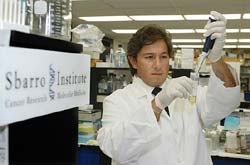Articles and reports from the Life Sciences and chemistry area deal with applied and basic research into modern biology, chemistry and human medicine.
Valuable information can be found on a range of life sciences fields including bacteriology, biochemistry, bionics, bioinformatics, biophysics, biotechnology, genetics, geobotany, human biology, marine biology, microbiology, molecular biology, cellular biology, zoology, bioinorganic chemistry, microchemistry and environmental chemistry.

Genes and behavior go together in honey bees so strongly that an individual bee’s occupation can be predicted by knowing a profile of its gene expression in the brain, say researchers at the University of Illinois at Urbana-Champaign.
This strong relationship surfaced in a complex molecular study of 6,878 different genes replicated with 72 cDNA microarrays that captured the essence of brain gene activity within the natural world of the honey bee (Apis mellifera). Even though most of th

Professor Ana Wünsch Blanco has presented her PhD, at the Public University of Navarre, on the application of molecular technologies in the identification and enhancement of the cherry fruit tree.
The application of molecular technologies in the identification and enhancement of the cherry tree is not something new. In fact, the varietal identification of fruit species has been accompanied, in the past few years, by the appearance of DNA markers. This has enabled an investigation of the geno

Cyclacel Limited, the UK-based biopharmaceutical company, announced today that it had entered into an agreement with MRC geneservice for the distribution of its proprietary Drosophila RNA interference (RNAi) collection. This agreement will allow access for MRC geneservice’s academic and commercial clients to the Cyclacel collection, for gene identification and validation purposes.
The Cyclacel Drosophila RNAi set covers some 13,605 genes defined in the FlyBase Drosophila genome database. The

The molecular mechanisms that may assist the tumor suppressing gene Rb2/p130 in blocking the progression of lung cancer cells has been clearly identified for the first time according to a study by researchers at Temple University’s Sbarro Institute for Cancer Research and Molecular Medicine.
The results of their study, “pRb2/p130 target genes in non-small cell lung cancer cells identified by microarray analysis,” appear in the Oct. 9 issue of Oncogene (http://www.nature.com/onc/).

Scientists at the University of Chicago have demonstrated that sleeping has an important and previously unrecognized impact on improving people’s ability to learn language.
Researchers find that ability of students to retain knowledge about words is improved by sleep, even when the students seemed to forget some of what they learned during the day before the next night’s sleep. This paper, “Consolidation During Sleep of Perceptual Learning of Spoken Language,” is being published i

Concerns about the ethics of using embryos created to treat infertile couples for stem cell research is discussed by researchers at St Mary’s Hospital, Manchester in this week’s BMJ.
Although the Human Fertilisation and Embryology Act 1990 allows the creation of embryos for research in the United Kingdom, the House of Lords Select Committee on stem cell research reported in February 2002 that embryos should not be created unless there is a demonstrable and exceptional need that cannot be met